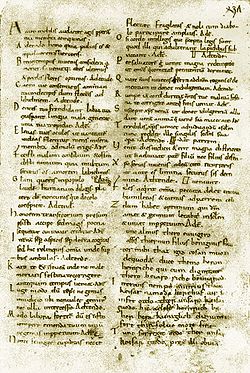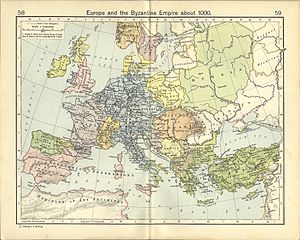Medieval Latin
Medieval Latin was the form of Latin that was used in the Middle Ages. It was used mostly by scholars and as the liturgical language of the medieval Roman Catholic Church, but it was used also as a language of science, literature and administration.
| Medieval Latin | |
|---|---|
 Carmina Cantabrigiensia, Medieval Latin manuscript | |
| Native to | Many small states |
| Region | Most of Europe |
| Era | Developed from Late Latin between 4th and 10th centuries; replaced by Renaissance Latin from the 14th century |
| Language family | Indo-European
|
| Early forms: | Old Latin
|
| Writing system | Latin alphabet |
| Official status | |
| Official language in | De facto in most Christian states during the Middle Ages |
| Language codes | |
| ISO 639-3 | – |
| Linguist List | lat-med |
 Europe, 1000 AD | |
Despite the clerical origin of many of its authors, Medieval Latin should not be confused with Ecclesiastical Latin. There is no consensus on exactly when Late Latin ends, and Medieval Latin begins. Some scholars have their surveys of it begin with the rise of early Christian Latin in the mid-4th century, but others have around the year 500.[1]

Important Medieval Latin authors
4th-5th centuries
6th-8th centuries
- Gildas (d. c. 570)
- Venantius Fortunatus (c. 530-c. 600)
- Gregory of Tours (c. 538-594)
- Isidore of Seville (c. 560-636)
- Bede (c. 672-735)
9th-10th centuries
- Ratherius (890-974)
- Thietmar of Merseburg (975-1018)
Medieval Latin Media
An illuminated manuscript of a Book of Hours contains prayers in medieval Latin.
The Prüfening dedicatory inscription from Bavaria, dated to 1119, composed in medieval Latin. It was printed rather than carved.
Notes
- ↑ Jan M.Ziolkowsky, "Towards a History of Medieval Latin Literature", in: F. A. C. Mantello and A. G. Rigg (eds.), Medieval Latin: An Introduction and Bibliographical Guide (Washington, D.C., 1996), pp. 505-536 (pp. 510-511)
References
- K. P. Harrington, J. Pucci, and A. G. Elliott, Medieval Latin (2nd ed.), (Univ. Chicago Pres, 1997) ISBN 0-226-31712-9
Other websites
- Wright, Thomas, ed. A Selection of Latin Stories, from Manuscripts of the Thirteenth and Founteenth Centuries: A Contribution to the History of Fiction During the Middle Ages. (London: The Percy Society. 1842.)
- Mental furniture from the philosophers, article on the influence of medieval Latin on modern technical vocabulary.